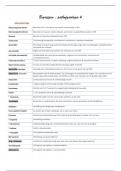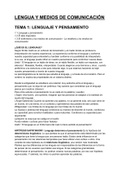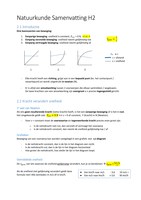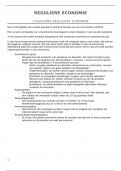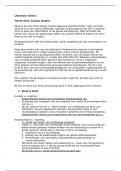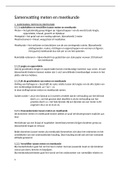History: A. The origin
Victimology
• Definition of VWS = The scientific study of the extent, nature, and causes of (criminal)
victimization, its consequences for the individuals involved, and societal responses, particularly
those of the police, criminal justice system, as well as voluntary and welfare services.
o (Criminal) victimization: Whom do we look at? Looking at victim of a crime (rape, murder)
or victim of an accident (falling down of a roof)?
• Often considered a subdiscipline:
o Psychiatry, law, social work.
o However, criminologists have the greatest influence.
o An essential component of offender studies within criminology, it has thus become an
integral part of criminological sciences.
Feministische criminologen hebben grootste impact gehad op de studie van slachtoffers!
Wie heeft meeste kans om slachtoffer te zijn?
D: door zijn life-style -> general life-style theory and routine activity theory
-> door zelf opstandiger te zijn + waar je leeft en wat je doet
Wij zijn biased, want velen denken dat B, vaker so is terwijl dat niet zo is!
Leopold Szondi: genotropism (1930s).
• Theory: Reciprocal attraction of the same/similar recessive genes influencing human behavior
(instinct).
o Genes determine who we are attracted to
o Was the first theory that dealt with the coming together of perpetrator and victim
o According to the theory, victimhood could be explained genetically (never been
empirically proven)
Eerder had victim een passieve rol, dus werd er geen aandacht aan geschonken tot 1930
Tijd 1930: theory over genen en biologie -> Szondi dacht ook in die gedachtengoed -> genes being
attracted to others -> waarom aangetrokken tot bepaalde persoon of waarom die bepaalde persoon
vermoorden
Victim selection is niet at random or just proximity -> er zit een denkproces achter!
Ted Bundy (1946-1989): Confirmed 36 victims in the 1970s.
Dit werd duidelijk in de ted bundy case -> hij kon zijn volgende so herkennen -> zijn ideale so: iemand die
al reeds so was geworden -> hij kon ze herkennen door hun manier van doen (hoe ze wandelen, hoe ze
hun tas dragen, …) = hij is een psychopaat (kunnen alle psychopaten hun so herkennen? = JA)
-> Victim Selection:
• A matter of opportunity.
• He claimed that he could identify a potential victim by the way she walks down the street, the way
she carries her head, her body language, etc. (Holmes & Holmes, 2010).
• Research confirms that victims exhibit certain typical body language, especially in the way they
walk (Grayson & Stein, 1981).
• Psychopaths are more accurate in recognizing potential victims.
1
,Dus wrong person at the wrong time/place = ja soms, maar er gaat vaak een selectieprocess aan vooraf
First mention of 'victimology'
• Mendelsohn, 1947: during the presentation of a paper.
o Wanted a discipline focusing on victims
o Considered the spiritual father of the victim movement.
• Werthem (1949) also advocates for a "crime victim-centered" science.
o Focused particularly on murder
First systematic investigation into crime victims by von Hentig (1941, 1948).
• "The Criminal and his Victim” (Von Hentig) (1948). Part 4: "The Victim's contribution to the genesis
of the crime."
o Critique of the one-dimensional perspective within criminology.
• "The law considers certain results and the final moves which lead to them. Here it makes a clear-
cut distinction between the one who does and the one who suffers. Looking into the genesis of the
situation, in a considerable number of cases, we meet a victim who consents tacitly (stilzwijgende
instemming) , cooperates (meewerken), conspires (samenzweren), or provokes (uitdagen). The
victim is one of the causative elements"
• The victim is one of the causative elements = was heel nieuw denken in die tijd, want eerder
was het slachtoffer louter passief
Exam: who was Von Hentig?: He was the first one who systematically investigated the victims of crimes.
Number of theoretical studies: (looked at documents)
• on victim types, the relationship between victim and offender, and the role victims play in certain
criminal phenomena (did they contribute, like fishing -> klicking on a link and being hacked) .
Number of empirical studies: (observations in the field)
• Murder, rape, theft, assault, fraud, extortion,...
• Martin Wolfgang: "victim precipitated criminal homicide" (1957).
o 588 murder cases between 1948-1952 in Philadelphia
o 26% VP cases where the victim was the first to engage in violence and therefor
murdered.
o VP = victim is not neutral but it did something to be a victim (victim precipitation)
• Menachem Amir: "Victim precipitated forcible rape" (1967).
o Active 'contribution': accepting a drink from a stranger, riding with a stranger.
o Passive 'contribution': not reacting strongly enough to sexual advances.
▪ = thin line between victim blaming and academic study of what happened
o Examples: alcohol, "reputation," place of residence, meeting place,...
o NO excuse for the offender.
Victim precipitation or victim-blaming?
• Especially in the 1970s, victim precipitation was increasingly seen as victim-blaming.
• Victim blaming can cause secondary victimization
• This has come to the attention of (feminist) victimology
VP research has contributed to two major criminological theories:
• Lifestyle theory (Hindelang et al., 1978)
• Routine activities theory (Cohen & Felson, 1979)
o Suitable target + motivated offender + absence of capable overseers
2
,At the core of these pioneers: victims of crimes.
• 1950s-1960s
• Also during the 1970s-1980s due to the emergence of professional assistance for crime victims.
1979: establishment of the World Society of Victimology
History: B. Evolution
60-70s: Debate about ‘Should we stick with victims of crime or including other victims?’
• Gradual broadening during the 1970s of the research focus.
o Similarities with war victims, prisoners in camps, and certain types of aggression and
discrimination (Nazism, Apartheid in Zuid-Afrika).
o Criminologists explore other crimes/phenomena: white-collar crime, environmental
crime,...
▪ Who is the victim here, what are we studying here, and what about perception?
▪ White-collar crime (Sutherland): research of companies (behaviour)
• Social legislations (how do you treat your employees), financial
legislations…
▪ Environmental crime: ex. pollution, Cancer because of the war in Vietnam
o Began to see that not only people can commit crimes, also states & organizations
• Also within the WSV, discussions about the research object of victimology.
o Difference between scientific victimologists and humanistic aid providers.
▪ Scientific: strong delineation that we can make as valid statements as possible
about a research population -> influence positivism
▪ Humanistic social workers: the consequences of victimization are similar,
regardless of whether it stems from crimes in the criminal code or not
• Division among victimologists: restrict to victims of crimes or include other victims?
o Refer to the definition of victimology by the World Society of Victimology (WSV).
o Prominent debate in the 1970s-1980s, but largely disappeared by the late 1990s-2000s
(see UN Declaration).
3
, • UN Declaration of Basic Principles of Justice for Victims of Crime and Abuse of Power
(1985)
o Unanimously adopted in the General Assembly.
o Objective: set minimum standards for states to meet in providing assistance to victims.
Late 60s, begin 70s: first victim surveys and first political concerns about fear of crime (people afraid of
going out)
On UN level they decides that they needed to do something for victims of crime, but there was the global
south -> they said: we agree, victims need support -> mike someone who was raped -> but also for
someone who was extorted by a colonial murdered regime needs compensation as well -> the western
said: hell no, we are not going to compensate for our behavior
- Debated in the Un declaration ….
- Then the south said: we agree but we also need to include victims of power
o Unanimously adopted in the General Assembly.
o Objective: set minimum standards for states to meet in providing assistance to victims.
• Was a compromise.
o Developed countries: victims of crime.
o Developing countries: victims of abuse of power should have the same rights as the first
category.
o Much more provision for the first category than for the second.
• See:
o 11. Where public officials or other agents acting in an official or quasi-official capacity
have violated national criminal laws, the victims should receive restitution from the State
whose officials or agents were responsible for the harm inflicted.
o 19. States should consider incorporating into national law norms proscribing abuses of
power and providing remedies to victims of such abuses.
▪ “should receive” and “should consider” -> you are not forced to corporate, you
should just consider it
▪ = so you see that it is not that strong
1. From “penal victimologie” to general victimology
Penal victimology
• Victims of crimes takes center stage
• Delimitation of victim
• Bayley 1991: penal victimology
1. They have suffered a loss a some significant decrease in well-being unfairly or undeservedly and
in such a manner that they are helpless to prevent the loss and
2. The loss has an identifiable cause and
3. The legal or moral context of the loss entitles the sufferer of the loss to social concern.
• Synonym: interactionist victimology
• There is a suffering, has a clear cause and the legal or moral context says there is harm
• There always need to be an identifiable cause
4
,General Victimology
• No restrictions, no exclusion of harm such as consumer fraud, pollution, work-related hazards and
illnesses, police violence, discrimination, poverty, and war (Elias, 1986).
o Poverty: is it your own choice or is it the responsibility of the state to develop policies to
change society and help to levitate?
▪ People in poverty die earlier (and dying is a harm, murdering someone is a crime
and has a lot of social reactions but when someone dies of poverty then it’s more
a ‘who cares’ reaction)
▪ Smoking is your own choice and when that person has cancer then there are 2
options
▪ The state helps them by treating the person (+ the people by paying
taxes)
▪ Or don’t do anything because it was his own choice to smoke
• Also referred to as assistance-oriented victimology.
Human Victimology
• Agree with general victimology but exclude accidents, natural disasters, and "acts of God."
o Here are a few exclusions
In favour of broadening:
• If victimology works on prevention and alleviation of suffering, then there should be no restrictions
on the type of suffering (poverty, HIV,...)².
• Artificial boundaries lead to priorities: one is worse than the other.
• Follow the broadening of the research focus within criminology.
Against broadening (see Fattah 1991):
• Loss of objectivity
o Abuse of power => ideological/normative
▪ What is abuse of power, what is the relationship?
▪ If someone was monitoring slavery, then it’s a crime but isn’t that the
economic system and is the problem really responsible?
• Too broad research domain
• Too political
o See research on victims who abuse law and order politicians (Elias 1986).
• Human victimology: qualitative distinction?
o What about work-related incidents.
• Anyone can feel like a victim.
o This can become an issue -> what is the balance?
2. From micro to macro victimology
Micro = looking at individual victimization -> who is the victim
Macro = looking at groups of victims
• Victim surveys become very popular in the 1970s.
o Shift from individual studies on victims of specific crimes to research on the volume of
victimization and the socio-demographic characteristics of victims.
o From individuals to groups
5
,3. From theoretical to applied victimology
• 1975-2000
• Early victimology sought causal factors of victimization and explanations for victimhood.
o Received a lot of criticism: victim-blaming
• In the 1970s, criticism of VP -> a new focus emerges within victimology.
o Helping and supporting victims.
o Rise of a political movement, evident in the nature of the research: from purely academic
to a humanistic movement (political activism).
• This transformation has had some major consequences
• The focus returned to crimes with a directly identifiable victim
▪ White-collar crime… disappeared into the background again
• Negative impact on criminal justice policy: worked strongly punitive
Feminist (hadden een belangrijke rol hierin) found in victim survey: that there is a reason why woman are
more fearfull
History: C. Definitions and concepts
Victim:
• “Victims mean persons who, individually or collectively, have suffered (passive) (but what about
active?) harm, including physical or mental injury, emotional suffering, economic loss or
substantialimpairment of their fundamental rights, through acts or omissionsthat are in violation of
criminal laws, including those proscribingabuse of power” (UN Declaration)
o Passive, culture of complaint, personal responsibility?
o “By the social construction of law itself, all crimes have a victim.” (Quinney)
o Crimes without victims?
o Through acts or omissions:
▪ Omissions = not doing something
▪ Ex: asbestos, cancer, when someone is drowning…
6
,Who is“the victim”?
• Result of our own morals, culture, perception, personal judgment.
o Discussion: prostitution is that rape or not?
▪ What if we say that prostitution is always rape?
▪ You give your body to a client = slavery
o Consent versus Sweden, France, UK, EU?
▪ EU: debating on the idea to criminalize the customers (not the sex workers)
▪ FR: customers are criminalized (not the sex workers because they are the victim)
▪ Scandinavian culture (Sweden): they see sex workers as victims
▪ = cultural differences
Om victim te zijn heb je verschillende elementen nodig:
• you need to see yourself as a victim
• You need to claim your victimization
• society needs to agree that you are a victim
= Result of our own morals, culture, perception, personal judgment.
Victimization
• The event or process by which someone becomes a victim or harm is inflicted upon a victim.
Victimalization
• The process in which society confers the status of a victim on the injured party.
• Vb: man en vrouw hebben ruzie en de man krijgt een slag in zijn gezicht -> de man kan zich als
slachtoffer van sagen en verwondingen benoemen -> maar velen zullen zeggen “man up” = niet
iedereen krijgt sympathie als slachtoffer
• Dus victimalization = the process where the man claims to be a victim and the society says: you
little man, man up
• If society agrees = you have power -> you can claim something: compensation or prison
sentence
• It is not neutral !!!
Devictimalization
• See the debate on prostitution. -> some think it is rape and others not
• The process of being a victim or nog -> society can take sides against labeling a person as a
victim
Secondary victimization
• The notion that through inadequate or insufficient treatment of victims within the criminal justice
system, victims re-experience their victimization a second time.
• Think of insensitive remarks during filing a police report.
Repeated victimization
• Research suggests that prior victimization is a strong predictor of future victimization.
o For example, individuals who have been victims of theft are 9 times more likely to
experience new victimization than those who have never been victims (Spalek, 2006).
o See: ted bundy = attracted to woman who have been victims
• People who have been victims of sexual violence are 35 times more likely to experience new
victimization than those who have never been victims.
7
, Lecture 2: Victimological perspectives and typologies
Introduction: Science and Humanism
Origin and evolution of victimology.
• Academic discipline <-> Activism/Advocacy Groups
o Victim precipitation as an academic discipline
o The activism and interest groups surrounding victimization
• Criminal (suffered bcs off a crime and a criminal offender), general (suffered due to state crimes,
holocaust or being beaten up by police officers -> no description or discrimination in who the
offender is), and human victimology (not talking about accidents).
• Key issue?
o “Victimology is […] a non-academic program under which a hodgepodge of ideas,
interests, ideologies and research methods have been rather arbitrarily grouped […] and
is characterized by a clash between two equally desirable orientations to human suffering:
the humanistic and the scientific.” (Cressey, 1992).
Discussion on the concept of the victim has implications for:
• Scope of the scientific discipline;
• (Political) discussions on the scope of interventions, legitimacy of victimhood (also see UN
Declaration).
• Scientific character of victimology?
o Popper: Progress in research through the identification of a problem.
o Then examine whether the available theories are suitable for explaining all aspects of the
problem.
o Thus, progress in research.
Distinction between science and humanism (Fattah, 1992).
• Humanism is more propagandistic <-> academic not sufficiently focused on social action.
o Humanism is quickly seen as propaganda, some criticism: too ideological, false
accusations, stigmatizing victims, unnecessary fear…
o Academic vision is seen as not focusing enough on social action
▪ Some researcher support activism (social action), you need to do more then
thinking about victimization
How you define a victim is not neutral!!!
From the positivistic view it is neutral
For the criminal view -> its the law -> what is written in the law (en de bijhorende events) is seen as a
victim, and the rest is bullshit
8
,The Positivist Perspective
= you will study a phenomenon and look for patterns. If patterns return you can create a preliminary theory
and test it -> it is about understanding reality by studying it.
Miers (1989):
"The identification of factors contributing to a non-random pattern of the victimization process,
a focus on interpersonal violent crimes, and a research interest in identifying victims who may
have contributed to their own victimization"
• Positivism tries to find patterns + trying to explain those patterns (= beginning of research)
▪ If you look at victim behavior patterns, then you can explain why someone
becomes a victim or not
• ‘contributed to their own victimization’: What did they do so that their chances to becomes
a victim increased
• Relative deprivation:
▪ Deprivation: You have less then someone else (not the same amount of money,
quality of housing…)
▪ Relative deprivation: you don’t necessarily have less, but you have to perceive/
feel that you have less then someone else
• Relative deprivation was considered in the research of 2004 as one of the
main reasons of extremism (left and right)
• But on the other hand there was deprivation (discrimination etc…)
• Government (policy makers) don’t want to recognize that they also contribute to crime
(because of structural discrimination etc…).
▪ They focus on the individual: the person itself contributes to their own
victimization
▪ So in the research of 2015 of radicalization, the government answers that the
blame lays by the individual (‘they must be crazy, hate Belgium…’)
• But they didn’t consider that they also have a roll in it (deprived
neighborhoods, poverty…)
• They want to find patterns and then come up with theories -> than they can find when and why
someone becomes a victim and others not
o Vb: vaker slachtoffer zijn als ze vaak naar een café gaan
o Know that there is always a limit for theories
• a focus on interpersonal violent crimes
o This connects to the criminal victimology
o Interpersonal = there has to be an interaction between offender and victim (vb iemand die
van dak valt omdat de baas geen goede veiligheidsmaatregels heeft genomen -> neen
want er is geen persoonlijke interactie)
o violent crimes = killing, stabbing, robing, raping (ze hebben het nog niet over state crimes
of milieu criminaliteit)
• may have contributed to their own victimization
o Wat heb je gedaan dat de kans op so-schap groter is dan bij iemand anders?
Corresponds to:
• Concept of 'conservative' victimology (Karmen, 1990) -> old school
• Concept of 'conventional' victimology (Walklate, 1989)
• Concept of 'administrative' victimology (Davies et al., 2003). -> refers to policies
9
, Common denominator: Focus on 'ordinary crime'.
• Relative deprivation:
o Deprivation = you do not have the same amount of money as someone similar to you (like
same degree)
o You have less than someone else
o But with relative deprivation = you don't necessarily have to have less than someone else,
you have to pesive ??? That you have less than someone else
o Notities vragen want tis mega vaag
Positivism: Two Core Assumptions
1) Behavior patterns can be objectively identified.
• No necessary connections in nature. Only patterns, sequences of phenomena.
• Significant influence within victimology.
o Victim surveys.
▪ Ex: If the survey asks why they did not report robbery and the most common
answers are ‘because we didn’t find the police’ -> then there is a pattern ->
research can begin
o Lifestyle theory.
2) Heavy emphasis on objectivity in knowledge production.
• Personal influences of researchers are not accepted
What about the victim?
• The starting point is that the term "victim" is not problematic.
• Victim is either recognized by criminal law or clearly by the suffering.
• Victimhood therefore becomes 'measurable,' right?
o You can find patterns, but that’s not easy
Criticism = it’s a static victim concept.
• What about power relations or processes contributing to the social construct of the victim? What
about social changes?
• Before victim surveys, dependence on police data -> police data is bias.
o Never relay only on police data!!
o Over-policing and under-policing
▪ Ex: poor neighborhoods are constantly monitored (= over-policing)
o Dark number & grey number
Conclusion:
• Positivistic victimology and victim surveys can provide snapshots of patterns/regularities of
victimization.
• But no social/historical explanations of the emergence of patterns across space and time.
o So, no insights into the irregularities of the criminal victimization process.
▪ They do not explain why certain people are more victimized or how come we
exclude categories of victims (= main criticism)
o No attention to the fact that the state and the criminal justice system can create new
victims.
o Ignoring the private sphere.
10


